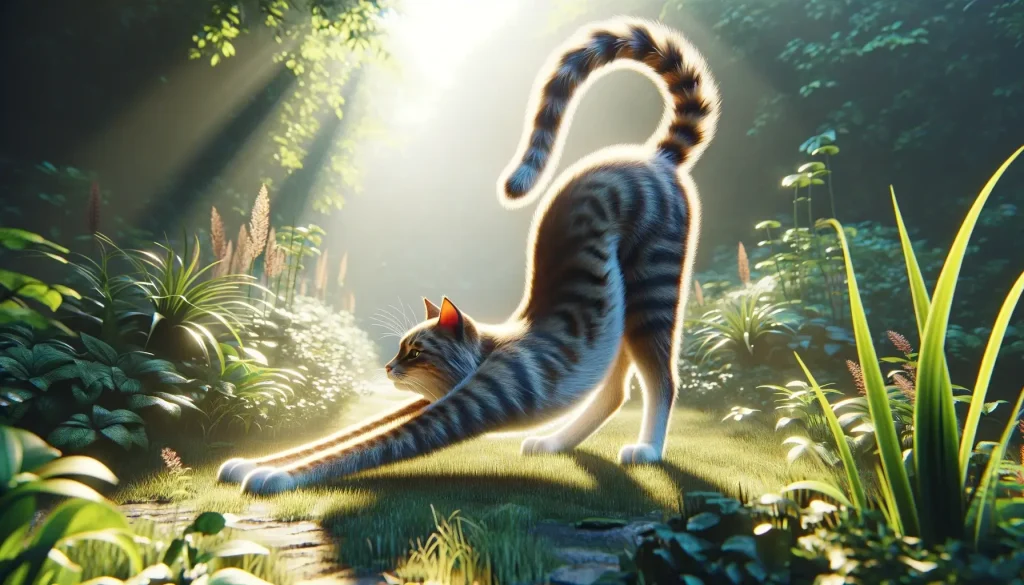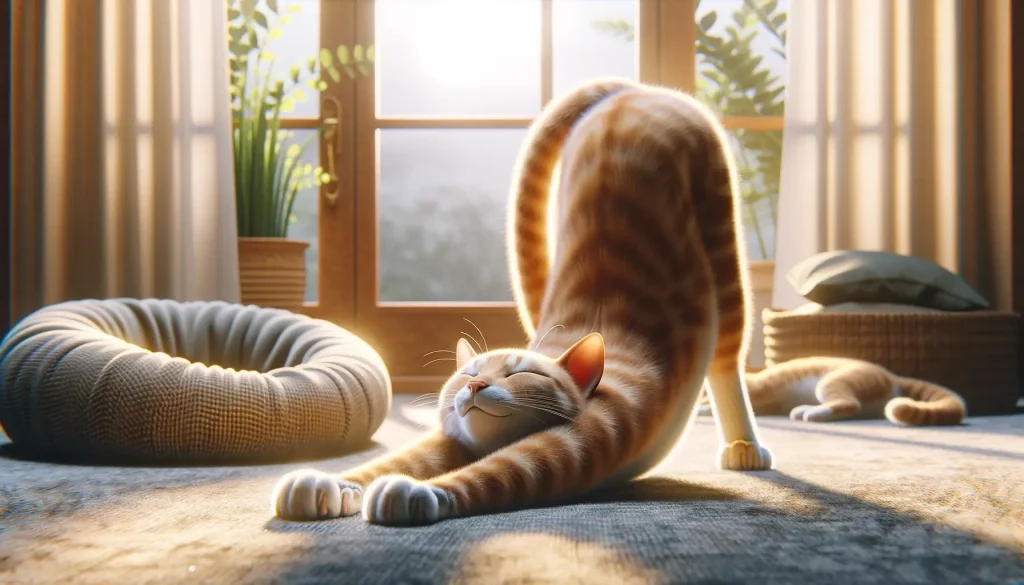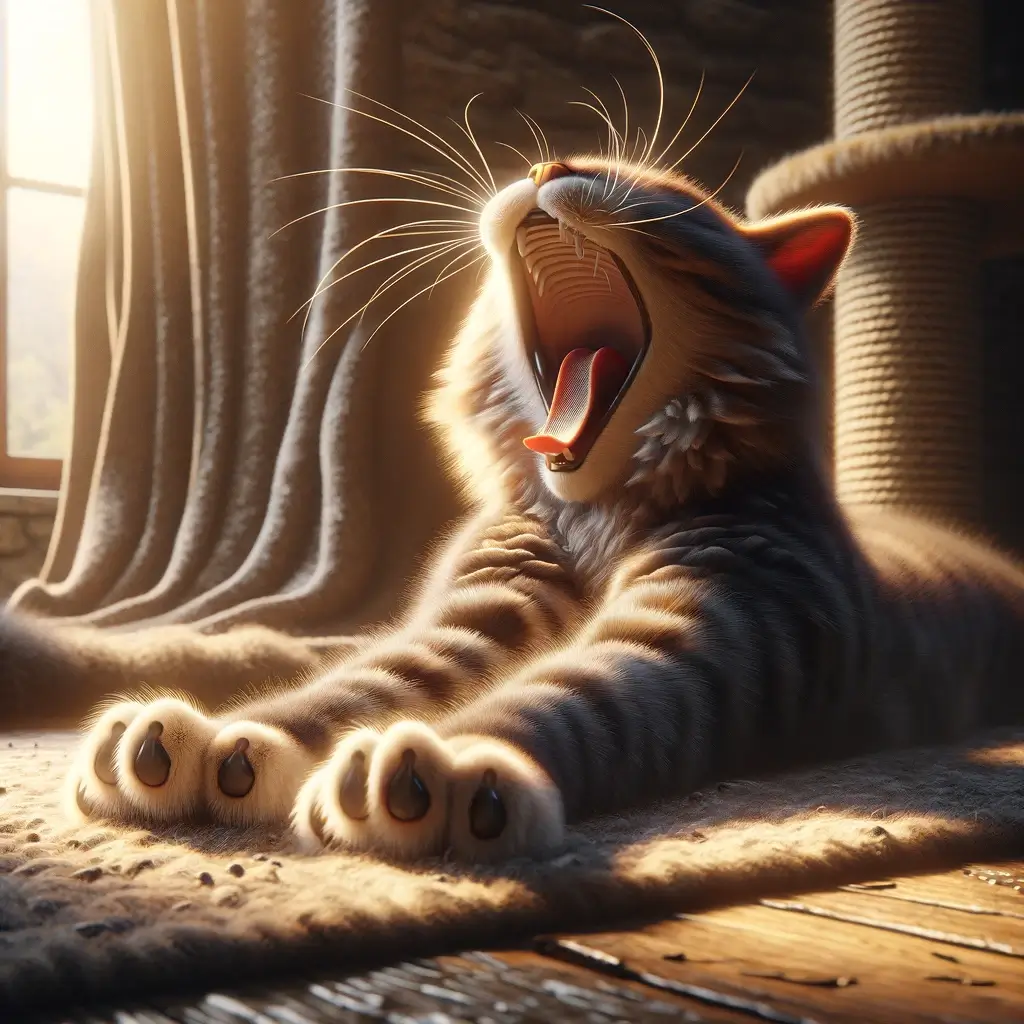
Cat’s Pandiculation Stretch
If you’ve ever watched your cat wake up, stretch intensely, and seem utterly content, you’ve witnessed pandiculation. This term might sound technical, but it’s something both humans and animals do regularly, especially when waking or feeling weary. Pandiculation is the act of stretching and stiffening the trunk and extremities, often accompanied by yawning. It’s a natural and instinctive movement pattern that serves as a reset for the body’s muscles and soft tissues.
Interestingly, aside from simply being a satisfying stretch, pandiculation plays a crucial role in maintaining our muscular and myofascial health. It provides interoceptive connections—feedback to the body about the state of its soft tissues. For cats, masters of relaxation and flexibility, this action happens multiple times a day, usually after napping. It’s not just a stretch; it’s a way to wake up their muscles and prepare for movement. Observing this, people can learn a lot about the natural ways to maintain flexibility and reduce muscle tension.
But why is watching a cat pandiculate so calming and inspiring? And more importantly, how can understanding and incorporating pandiculation into our own routines improve our wellness and flexibility? Let’s stretch into the answers to these questions.
Why Do Cats Stretch So Much?
Ever noticed how cats always seem to be stretching, particularly after a long nap? This behavior is known as pandiculation. It’s not just a simple stretch; it’s a complex process involving the tension and relaxation of muscles. When your cat arches its back and tenses its muscles, it’s engaging in a natural, instinctive action that benefits its body in numerous ways.
Understanding pandiculation can unlock secrets to enhancing our own wellness and flexibility. This instinctive movement helps maintain the functional integrity of the body’s soft tissues. Pandiculation involves stretching and stiffening of the body, often accompanied by yawning, and it’s something both humans and animals do, especially upon waking or when feeling tired.
Why are cats such great role models for this? Simply put, they do it all the time. After any one of their numerous daily naps, cats will rise and perform a series of stretches, beginning with an arch of the back and a full-body stretch. Observing this behavior in cats can be both calming and educational. It serves as a reminder of the importance of regular stretching and how it can relieve muscle tension and enhance flexibility.

At-Home Care and Vet Visits for Cats
As pet owners, understanding how to care for our cats at home and recognizing when professional help is needed is crucial. Let’s dive into what you can do and when it’s time to visit the vet.
Home Care for Your Feline Friend
Pandiculation, or cat stretching, is more than just a delightful display; it’s essential for their well-being. At home, you can support your cat’s flexibility and muscle health by:
- Providing plenty of playtime to encourage movement and stretching.
- Setting up a comfortable resting area that allows them to stretch out fully.
- Observing their stretching routines to understand their normal behavior.
Encouraging natural behaviors, like pandiculation, enhances your cat’s health and can prevent issues related to inactivity such as muscle stiffness or loss of flexibility.
Noticing Changes in Behavior
Beyond regular care, pay attention to changes. If your cat suddenly stops stretching or shows discomfort while doing so, it might be a sign of underlying issues.
When to Seek Veterinary Care
It’s important to know when a professional’s input is needed. Visit the vet if you notice:
- Decrease in regular stretching or pandiculation.
- Signs of pain or discomfort during movement.
- Unusual lethargy or reluctance to move.
These could be indicators of myofascial pain, injury, or other health concerns requiring immediate attention.
Your Cat’s Muscular Health
Keeping your cat agile and pain-free involves simple yet effective steps. Focus on activities that encourage natural behaviors like pandiculation. Here’s how:
- Enrich your cat’s environment with interactive toys that stimulate stretching and playful hunting behaviors.
- Create cozy resting spots with enough room for your cat to stretch fully.
- Engage in daily play sessions to promote active stretching and strengthen your bond with your cat.
Spotting early signs of discomfort or reluctance to stretch is crucial. Seek veterinary advice if you notice any changes in your cat’s stretching habits or overall mobility. Remember, pandiculation is as beneficial for pets as it is for humans. It not only boosts muscle health but also enhances emotional well-being.


The Science Behind Cat Stretching
Why do cats stretch? The answer is pandiculation. It’s a fancy word for a common behavior. Cats do it, humans do it, and it feels great. When cats wake from a nap, you’ll often see them stretch their body, arch their back, and possibly yawn. This isn’t just a stretch; it’s a complex, instinctual behavior with real benefits.
Pandiculation is about tension and relaxation. First, there’s a tensioning of muscles, then a relaxation. This sequence helps maintain the health of the body’s soft tissues. It’s more than waking up the body; it’s about giving feedback to the muscles. This feedback is crucial for the body’s awareness of how its muscles and soft tissues are doing.
Cats are champions at pandiculation. They do it all the time, and there’s a reason they’re so flexible and relaxed. By stretching and yawning, they’re tuning into their body’s needs. They’re maintaining muscle and soft tissue health naturally. Humans can learn from this. By adopting similar routines, we can improve our flexibility, reduce muscle tension, and enhance overall well-being.
Here’s what you can do:
- Watch videos of cats stretching if you don’t have one at home. Observe their techniques.
- Try stretching when you wake up in the morning. Mimic the tension and relaxation seen in cats.
- Notice how you feel before and after pandiculating. Look for changes in muscle tension and flexibility.
Observing and mimicking cats can teach us a lot about pandiculation. It’s an easy and effective way to connect with our bodies, improve flexibility, and maybe even relax a little more. Just like our feline friends, embracing the natural wisdom of our bodies can lead to better health and well-being.